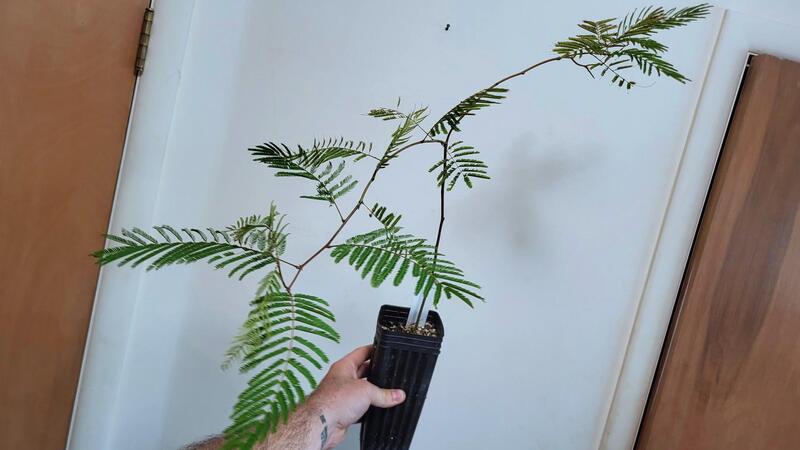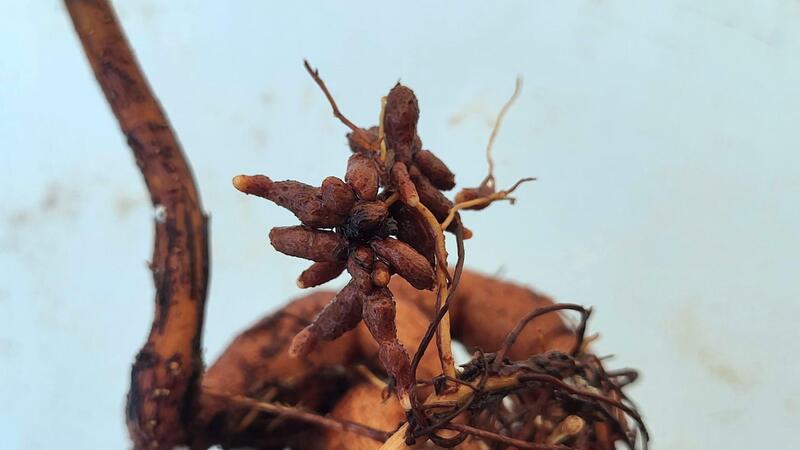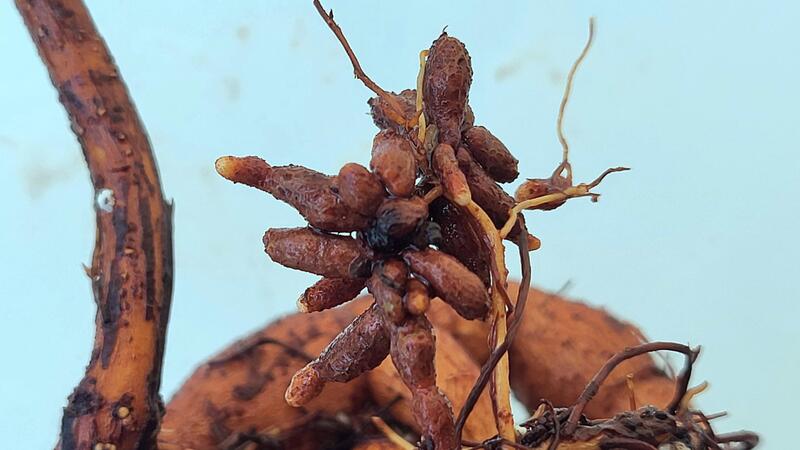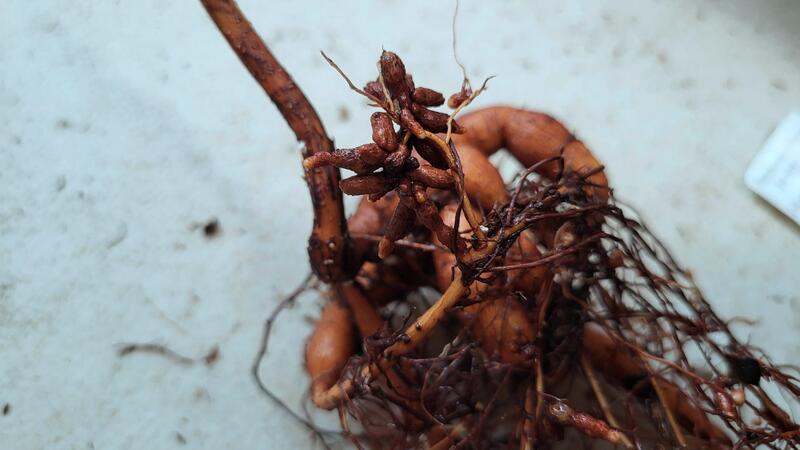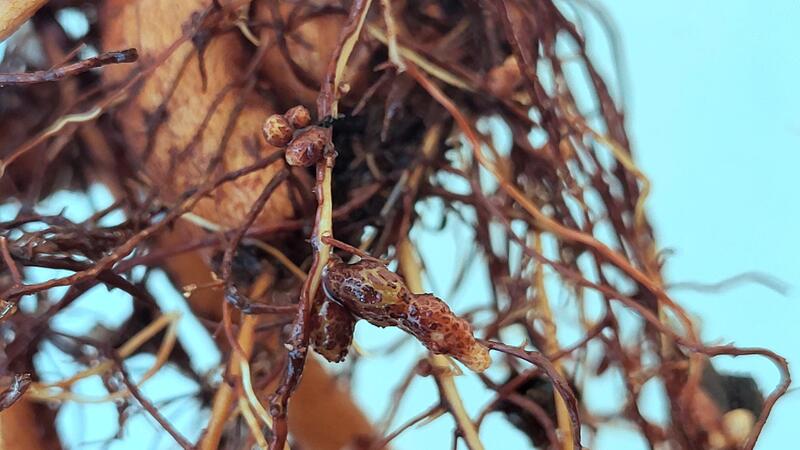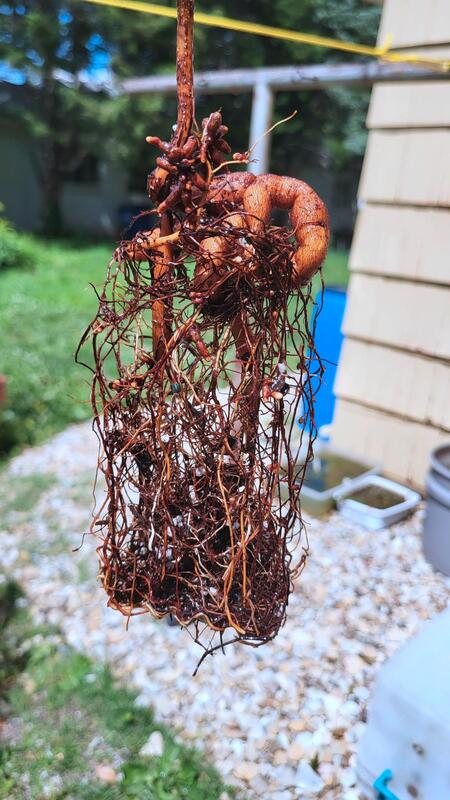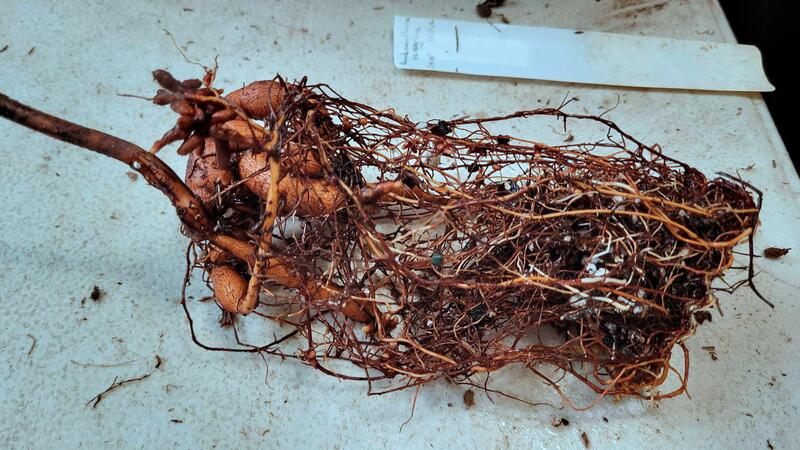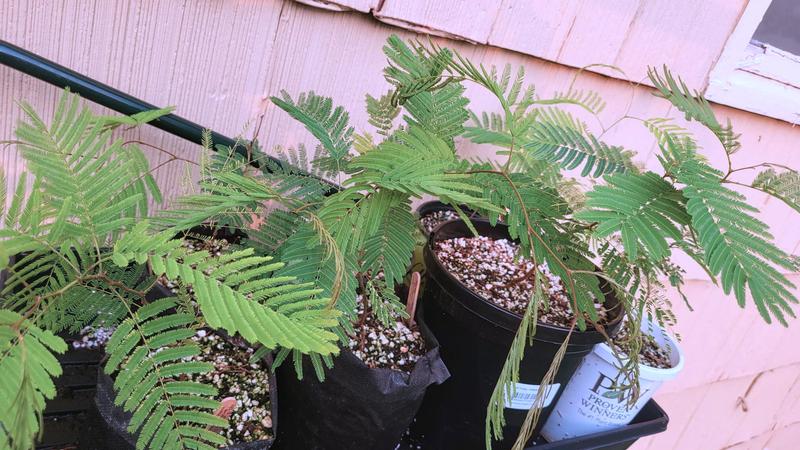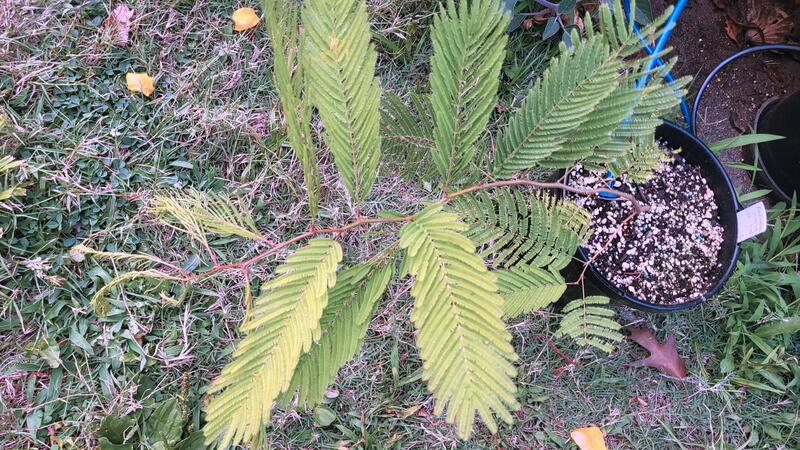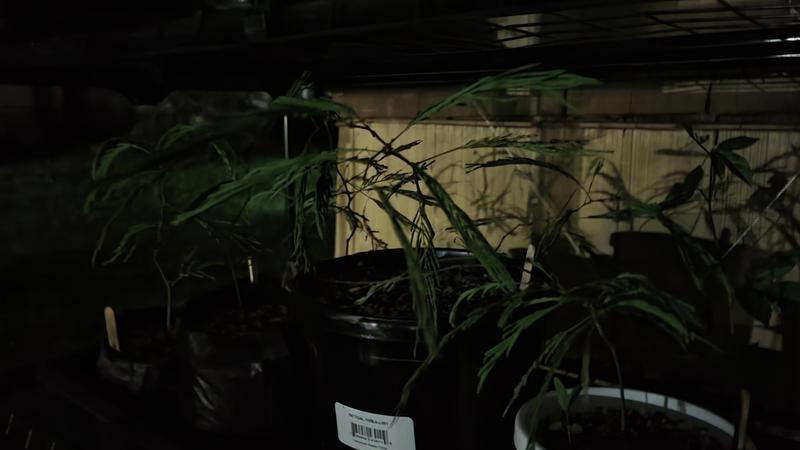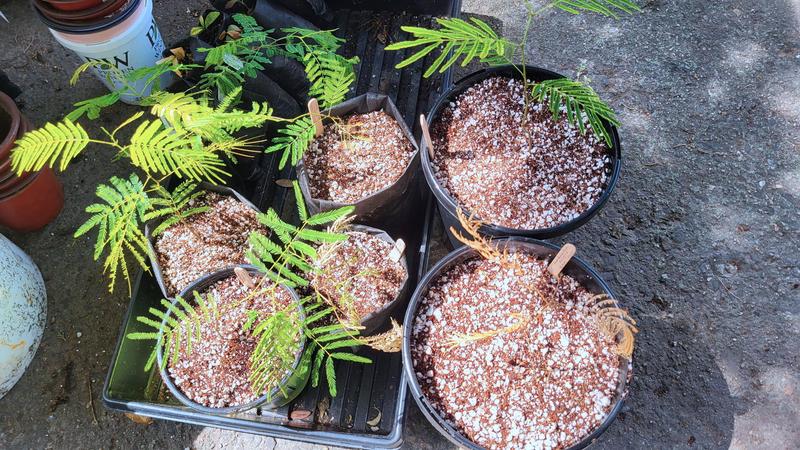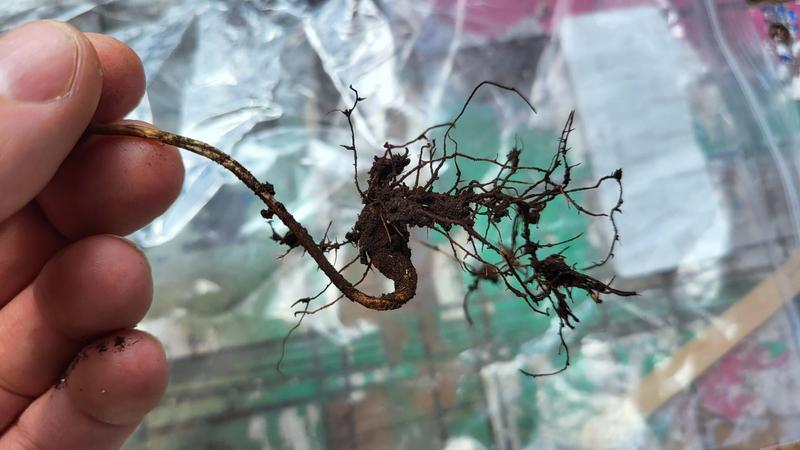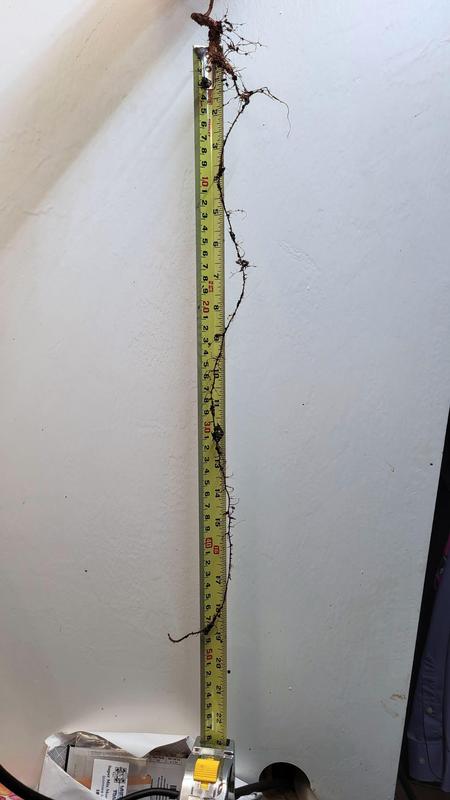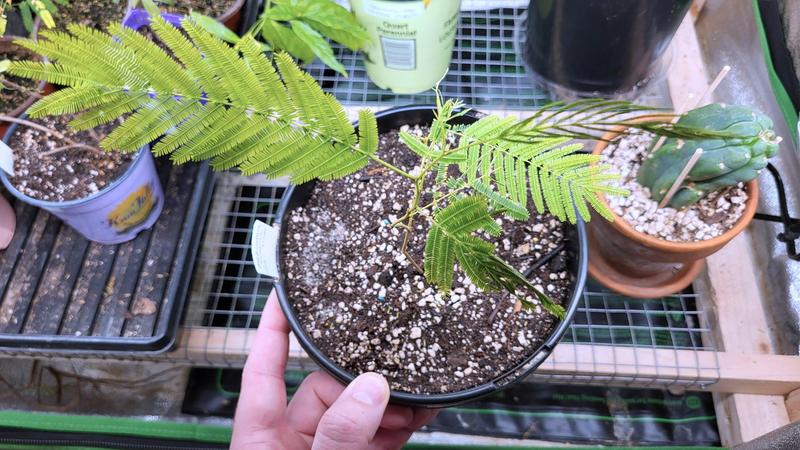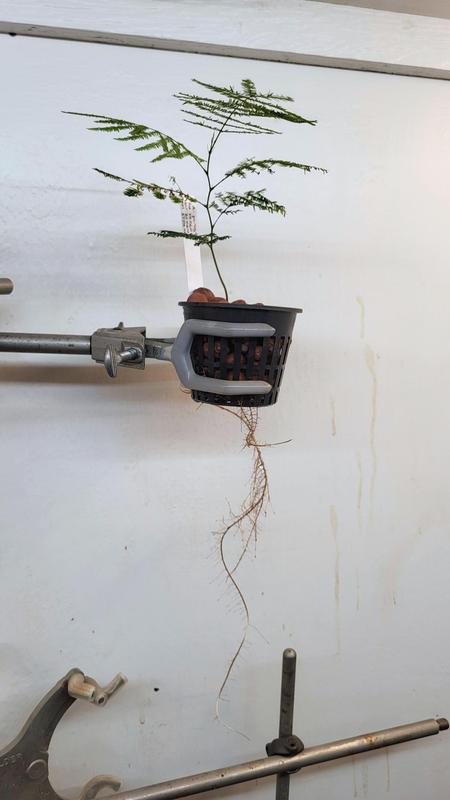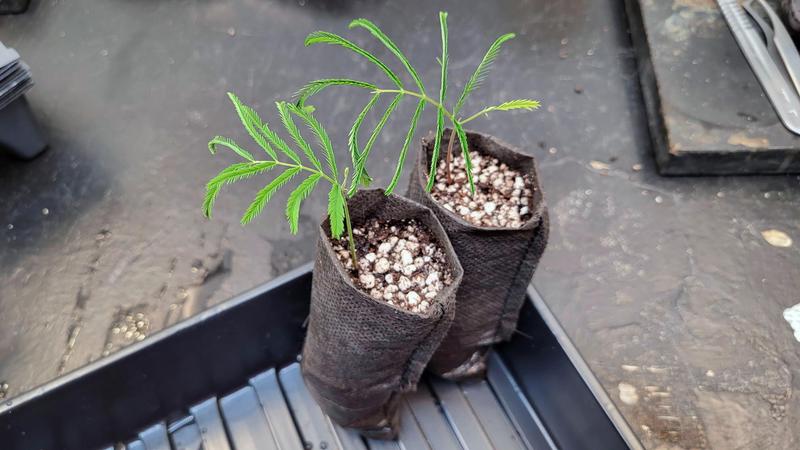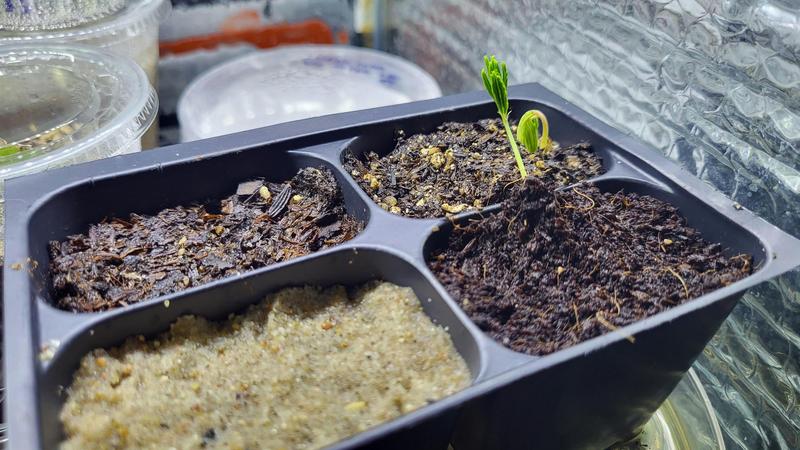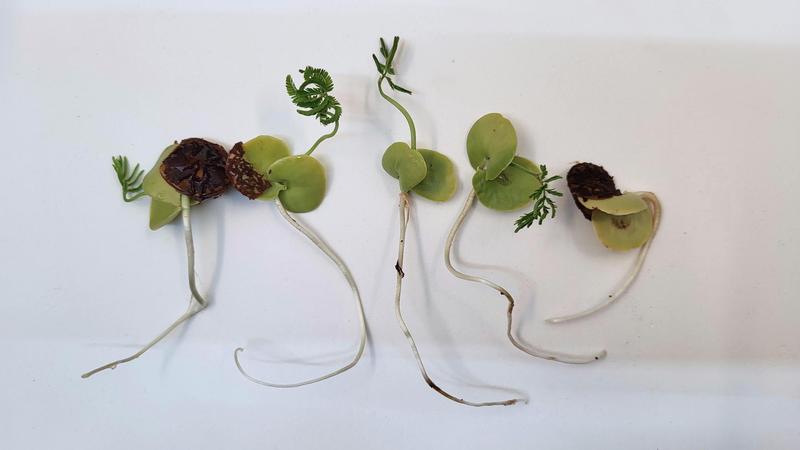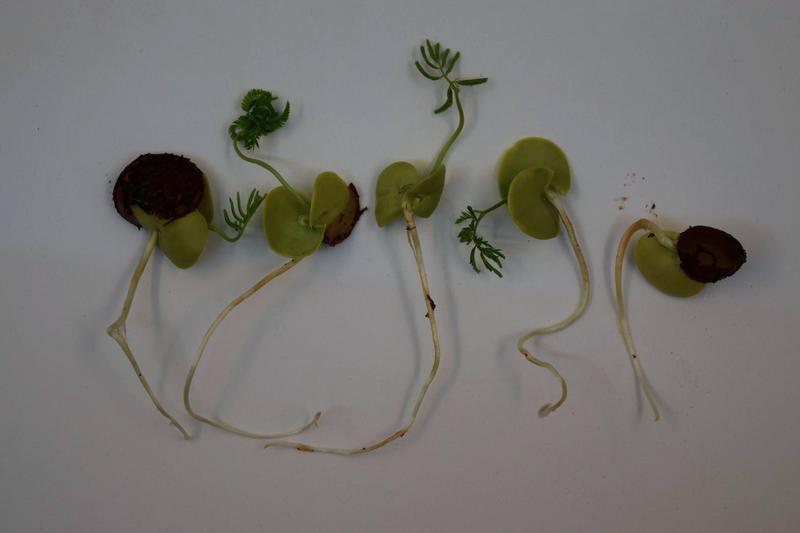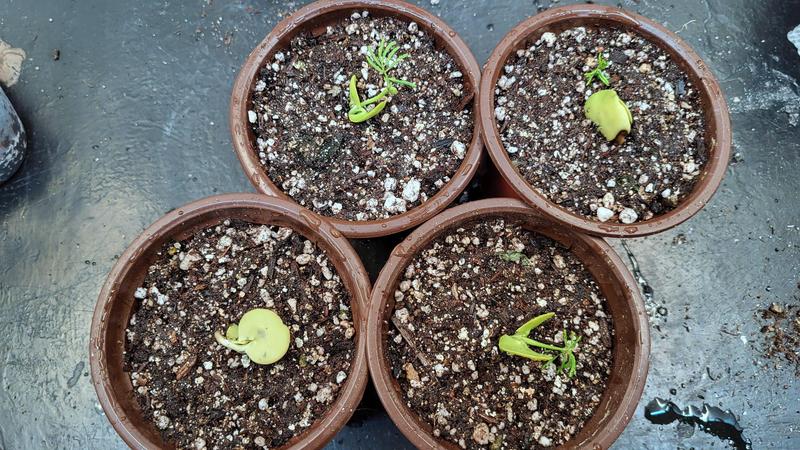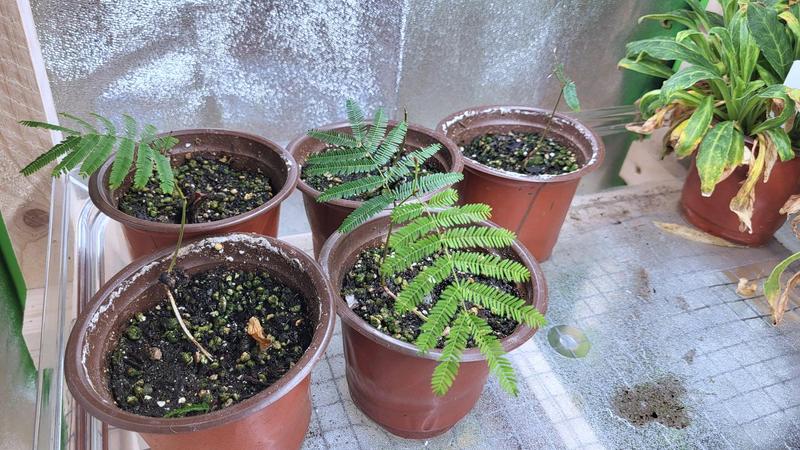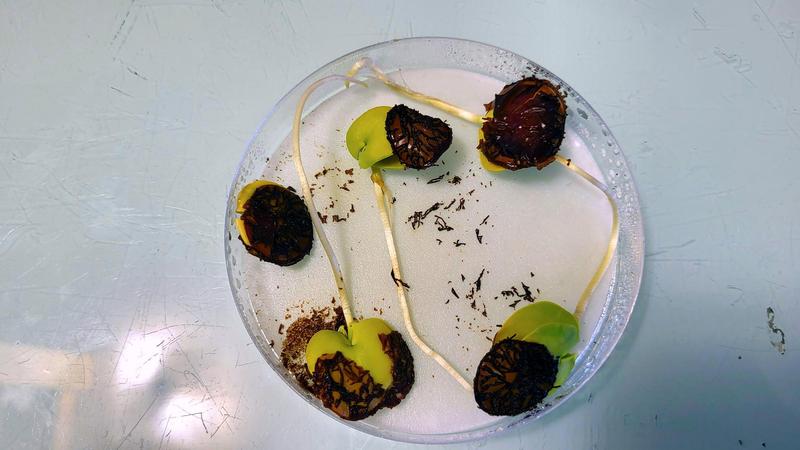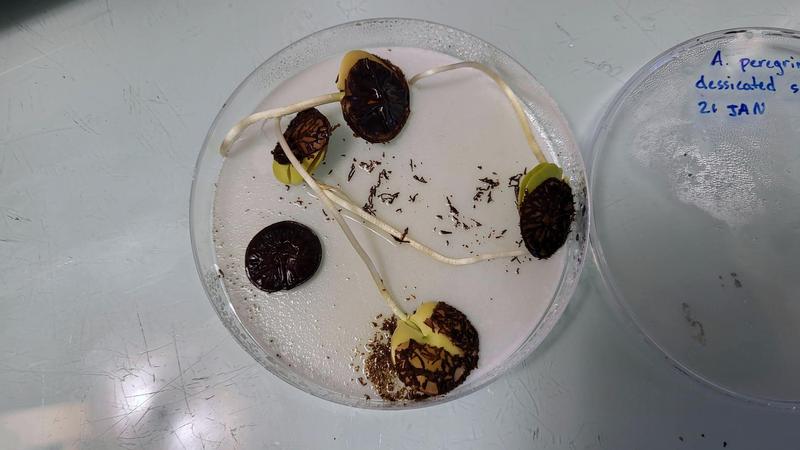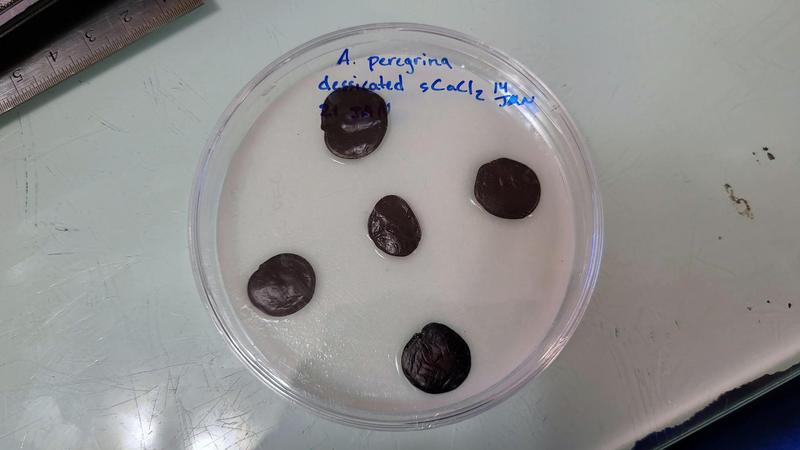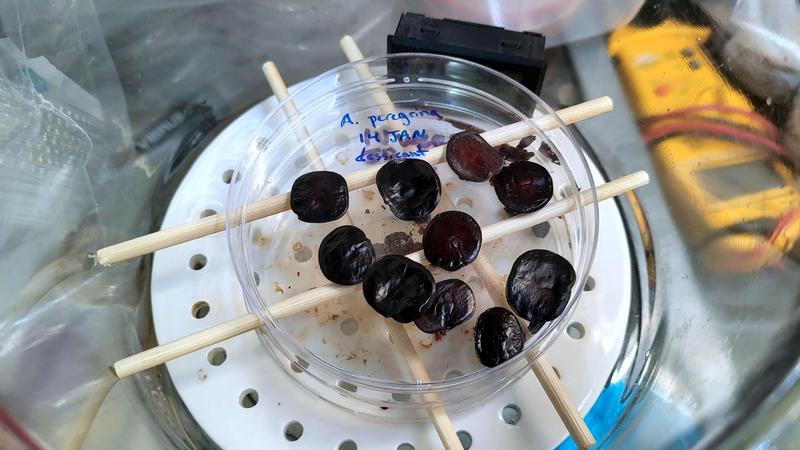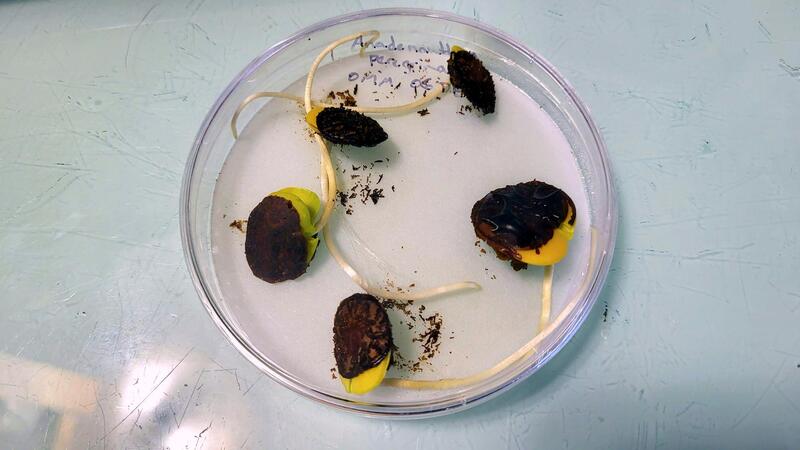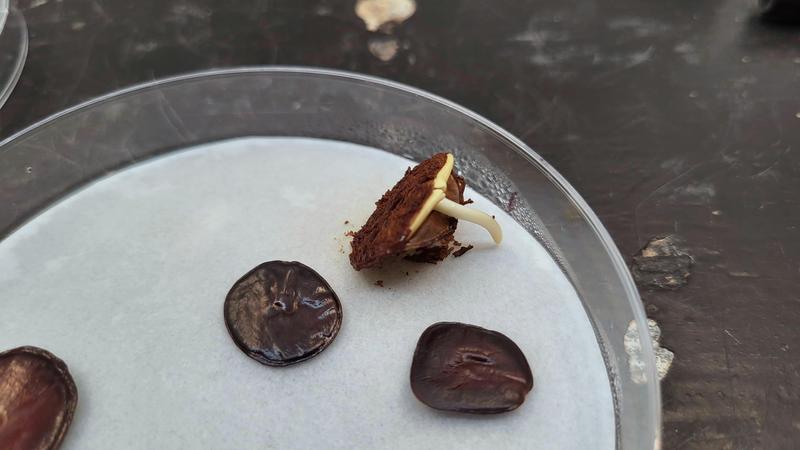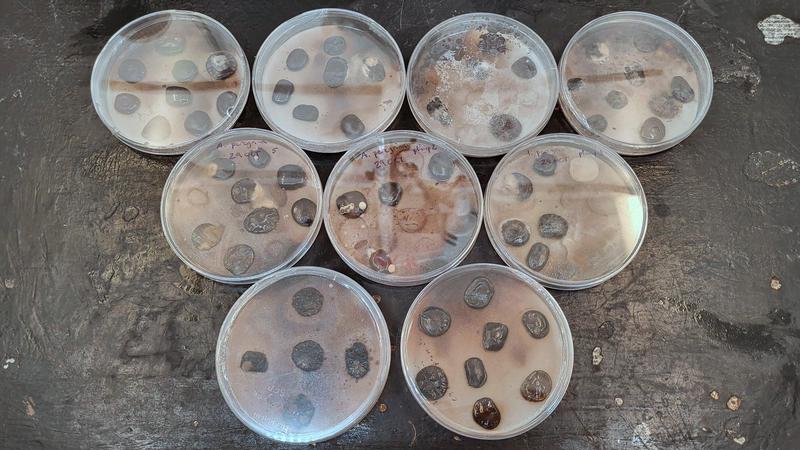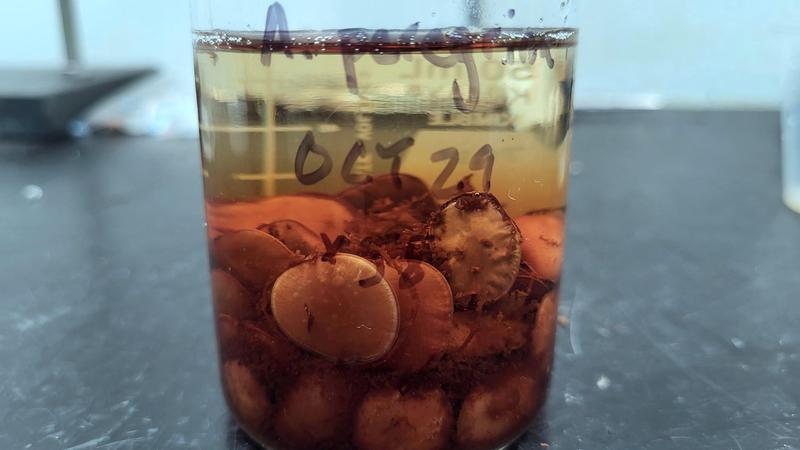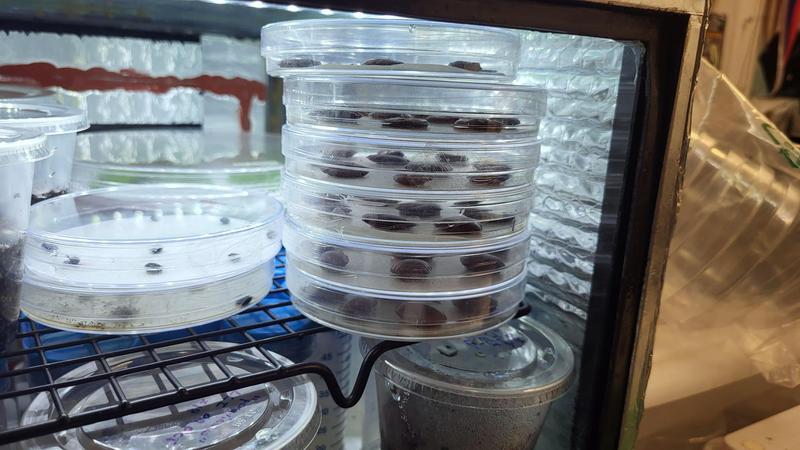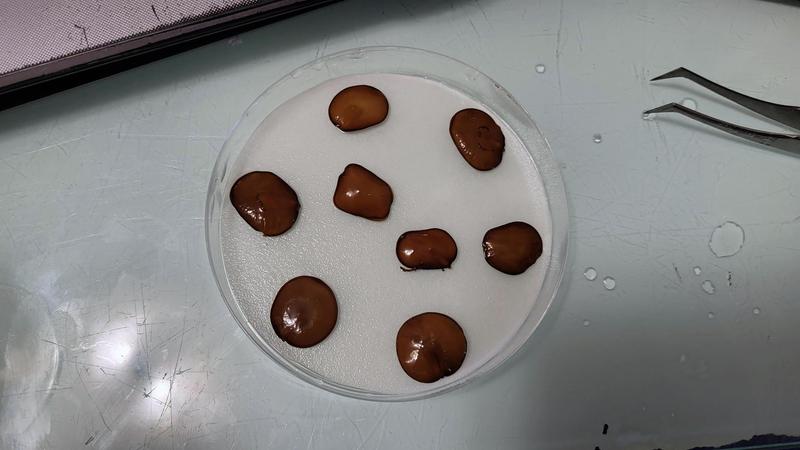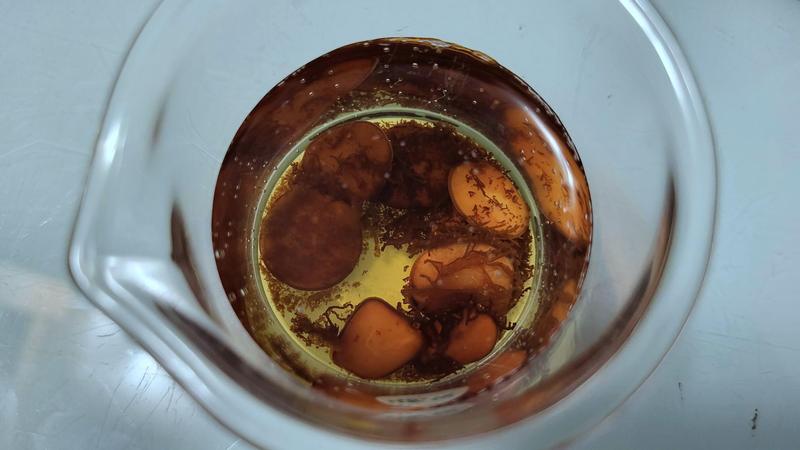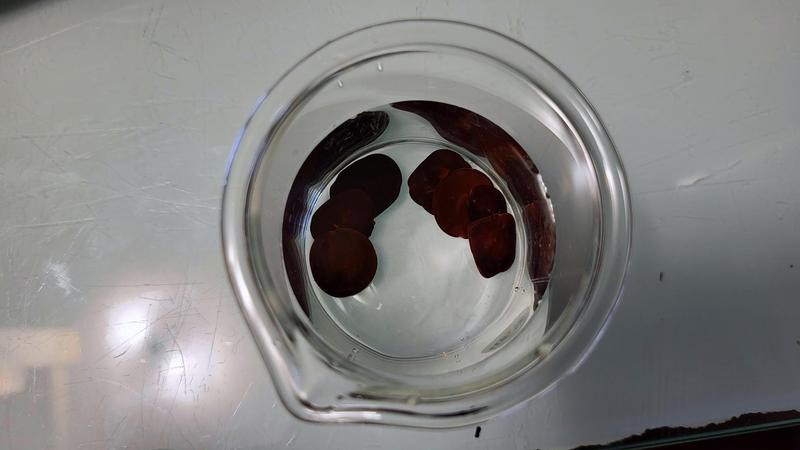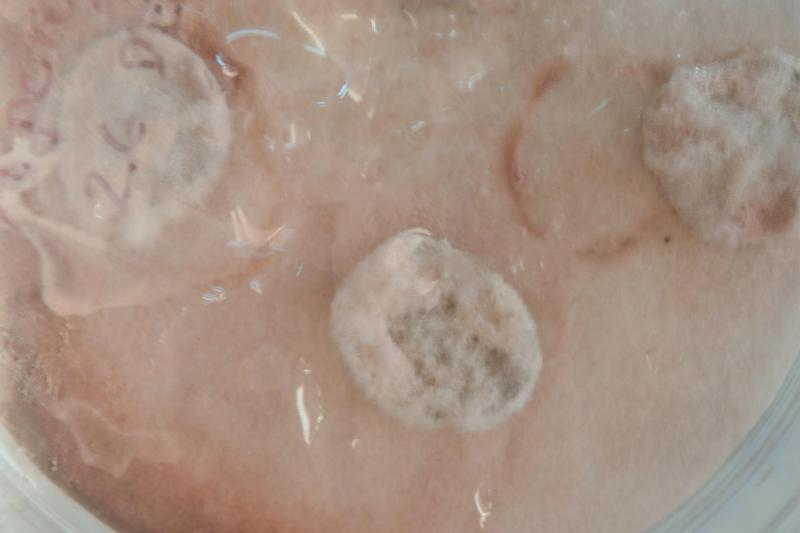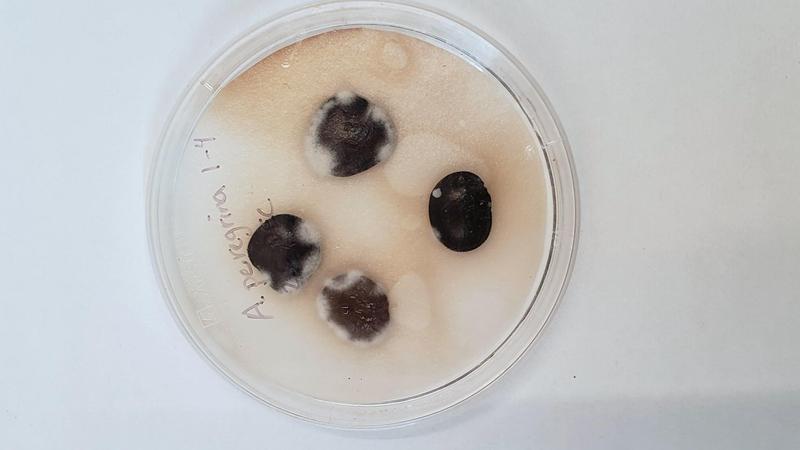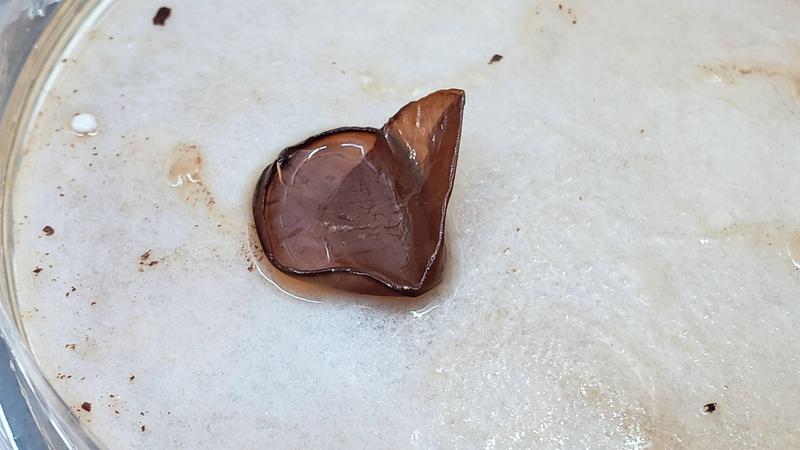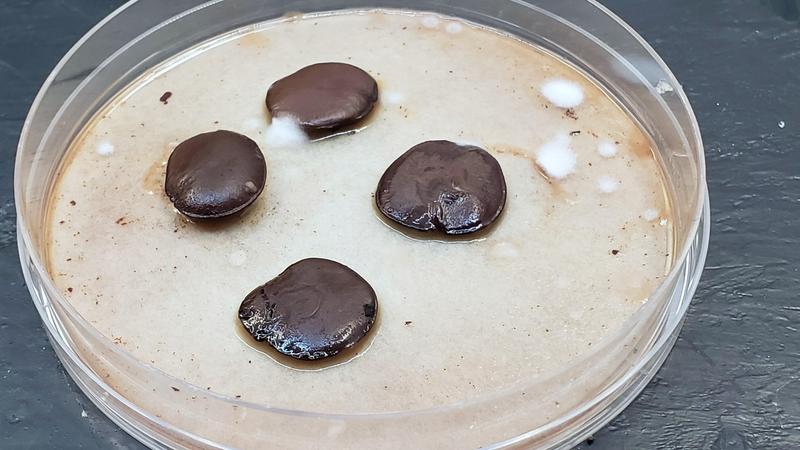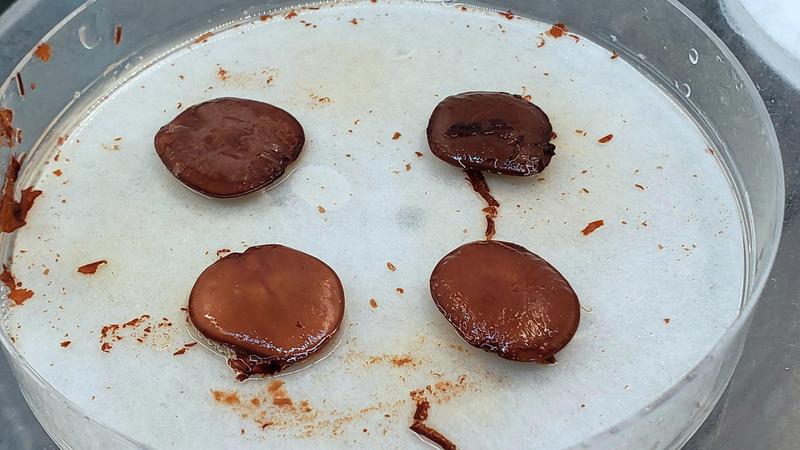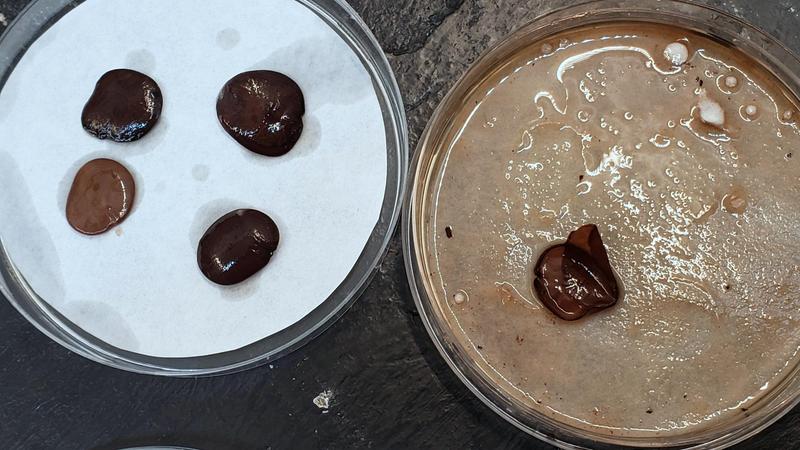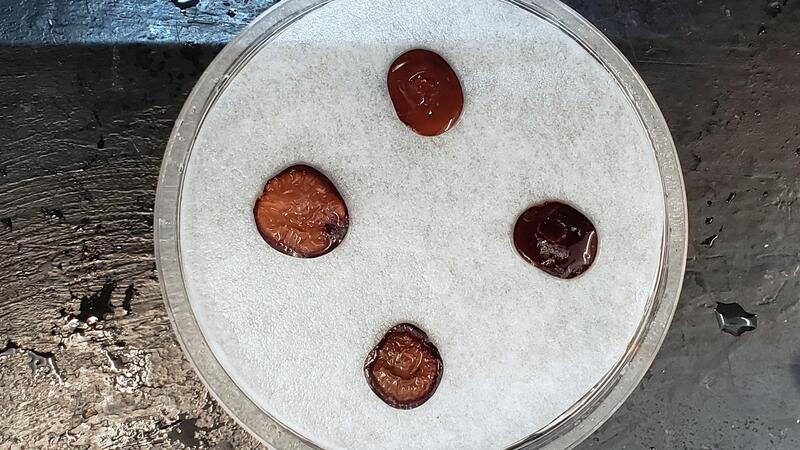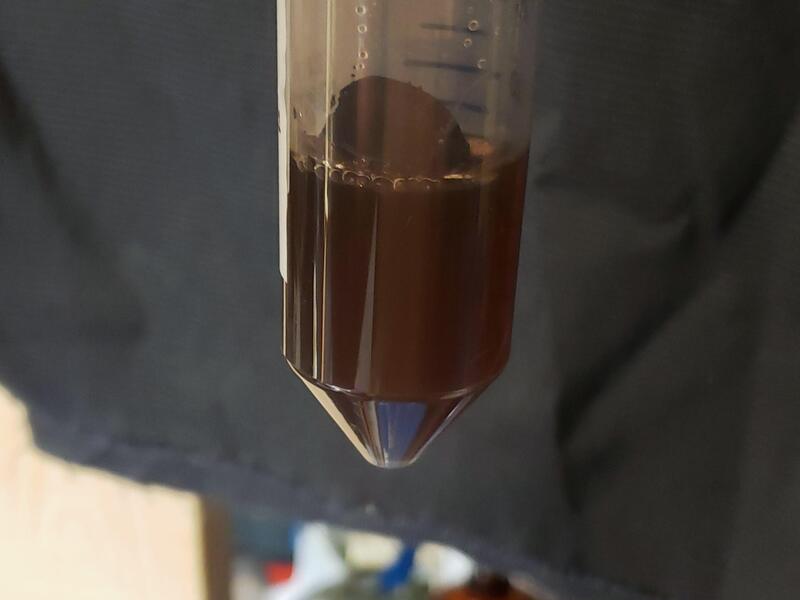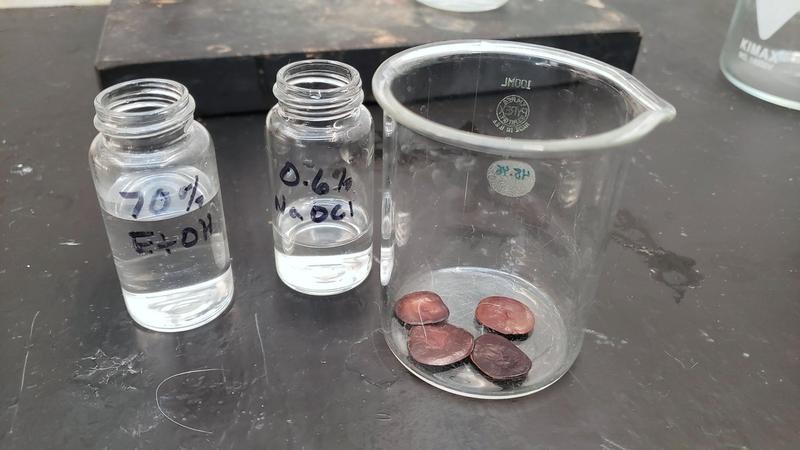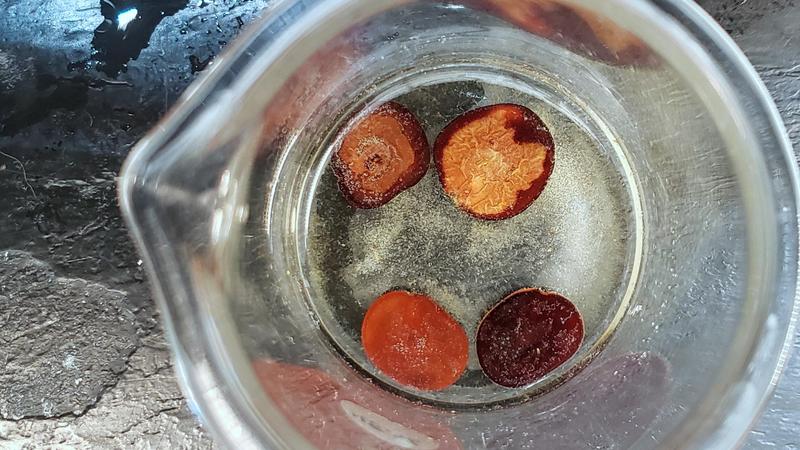Anadenanthera peregrina
Propagation
Self-compatible (secondary source; unverified).[1]
Peregrina is generally self-incompatible (~10% compatibility) with protandrous flowering. However, the old stands of peregrina may gradually increase autogamy to survive.[2][3]
Protandry.[2]
Barochoric.[2]
Peregrina has a higher outcrossing rate than colubrina.[4]
Manually self-pollinated flowers produce fewer seeds (2.03 per fruit) than open-pollinated outcrossed flowers (5.6-6.05 per fruit). No fruits are produced without pollination (manual or insect). There is no evidence of agamospermia. This likely indicates a genetic mechanism that promotes outcrossing.[2]
Germination
| media | germination | temperature °C | note | citation |
|---|---|---|---|---|
| filter paper | germination | [5] | ||
| soil | germination | [5] | ||
| soil:sand 1:1 | germination | [6] | ||
| Plantmax Forestry Substrate:compost:vermiculite 6:3:1 | fertilizer | [7] |
High germination rate (~90%) using double-layer filter paper on Petri dishes on a lab shelf indoors.[5] Slightly lower germination using direct sowing (40-70%) in unheated greenhouse conditions.[8][9]
Similarly, high germination rates are seen in another experiment at 25 °C.[10]
When directly compared, vermiculite has a higher germination fraction than filter paper or sand (96%, 85.5%, 77%, respectively) at 30 °C.[11]
High particle density and media contact facilitate water absorption during germination leading to greater initial seedling vigor. This doesn’t necessarily translate to better growth later on due to the decreased gas diffusion in these media.[8][12]
The mean emergence time is approximately 14 days after sowing in bulk media.[8]
Emergence percentage and rate in vermiculite, earthworm humus, and two types of sand were statistically equal.[13]
Seeds are tolerant to drying and freezing.[14][11]
Relative humidity has a significant effect on the storage viability of peregrina. Seeds maintain high viability in storage at 20°C at 23-55% RH or below (60-70% germination at 22 months). The best storage conditions are 40-50% RH at 10°C, where seeds maintain initial viability (80%) germination for at least 22 months.[15]
Fresh seed rehydration followed by dehydration for 24 hours at 37°C reduced the germination to about 30% similar to treatment with 10-4 M ABA.[16]
Simulated fire conditions negatively impact peregrina germination.[17]
Seeds contain endophytes from the Mythylobacterium, Staphylococcus, Friedmaniella, Bifidobacterium, Delftia, Anaerococcus, and Actinomyces genera.[18]
Fruit size is not a good indication of physiological ripeness and ultimate germination of colubrina seeds.[19]
Ionic leaching during imbibition increases with temperature (except calcium) but does not affect the germination rate. Hypothetically it could affect later growth, however.[10]
Germinations take approximately two to six days. Filter paper and vermiculite are slightly faster than sand germinations.[11]
Seedling survival is around 65%.[8]
Vegetative
In-Vitro
| basal media | supplements | source | target | note | reference |
|---|---|---|---|---|---|
Cultivation
| Planting density (m2) | inter-row space (m) | intra-row space (m) | note | reference |
|---|---|---|---|---|
| 6 | 3 | 2 | pyrolysis | [24] |
| 9 | 3 | 3 | pyrolysis | [24] |
| 12 | 4 | 3 | pyrolysis | [24] |
| 16 | 4 | 4 | pyrolysis | [24] |
| 25 | 5 | 5 | pyrolysis | [24] |
Pioneer species with rapid uptake of nutrients for fast growth.[25]
Being Fabaceae, peregrina can form root nodules with mycorrhizal fungi that benefit many aspects of plant growth and resistance.[26]
The roots accumulate more arsenic that the shoots of peregrina (arsenic-accumulating species).[26]
Cultivated stand of 1111 trees per hectare.[27] Wild stands have 10-15 trees per hectare.[4]
Harvest
Yield
| product | source | yield per season (kg/ha) | note | reference |
|---|---|---|---|---|
| product | source | yield per plant | note | reference |
|---|---|---|---|---|
Soilless
Peregrina can be cultivated in wicking hydroponic systems.[26]
Soil
| soil type | pH | C-content % | precipitation | temperature (°C) | altitude (m) | note | reference |
|---|---|---|---|---|---|---|---|
Fertilization
| type | rate | time | note | reference |
|---|---|---|---|---|
| goat manure | 0/25/50/75/100% | presowing | seedlings | [29] |
| Basacoat Mini 6M (13-06-16) | 0/2/4/6/8/10 kg/m3 | presowing | fertilizer | [7] |
Peregrina is a pioneer species that tolerate nutrient-poor soils with good drainage.[11]
Forest species are particularly growth restricted by phosphorus availability. High seedling survival and growth are seen in soils with higher available phosphorus.[9][30]
Approximately 50% of nitrogen found in the above-ground biomass of peregrina is fixated by rhizobium in natural stands.[27]
Fish waste is an effective fertilizer for A. colubrina.[25]
Peregrina in sterile soil inoculated with mycorrhizal fungi and rhizobia (Glomus spp., Acaulospora spp.; isolated from corn) had 60% higher biomass than uninoculated or naturally grown trees after ten months. Inoculation with only one genus was not statistically different from sterile soil. The species present in natural soil (Glomus microaggregatum, Glomus etunicatum, Glomus sp., Enthrophospora sp., Gigaspora sp., and Acaulospora sp.) did not increase growth beyond that of sterile soil despite greater numbers and fraction of root nodulation than inoculated trees.[31]
In another study, rhizobia-inoculated peregrina had significantly higher biomass than noninoculated plants but much less than ammonium nitrate fertilized plants. No overt symptoms of deficiency were noted.[32]
Various mycorrhizal fungi colonize peregrina with different efficiencies depending on the soil composition. Glomus etunicatum and Acaulospora scrobiculata were particularly effective at promoting growth.[30]
Peregrina that are inoculated with mycorrhizal fungi can divert more carbon toward the shoot. In effect, the increased nutrient absorption efficiency due to mycorrhizal fungi is an effective substitute for roots.[30]
Optimal fertilization of peregrina seedlings in greenhouse pots with Basacoat Mini 6M (13-6-16) controlled release fertilizer is approximately 5.5-6.7 g/L.[7]
Temperature
Lighting
| fixture type | photoperiod | illumination | note | reference |
|---|---|---|---|---|
Leaf number, leaf dry mass, specific leaf mass, leaf area, and plant height were positively influenced by light quantity, with the best results obtained in full sun.[8]
Pests
Ecology
Morphology
| character | measurement | unit | notes | reference |
|---|---|---|---|---|
| height | 7.4-8.4 | m | 56 months old | [24] |
| DBH $ | 6-9 | cm | 56 months old | [24] |
| trunk density | 0.66 (0.64-0.69) | g/cm3 | 56 months old | [24] |
$: Diameter at Breast Height
Shrub or small tree with irregular and contorted branching.[33]
Grows to a height of 35 m and diameter at breast height of 120 cm.[4] More typically it is 3-27m tall with a 20-40 cm trunk.[33][34]
Germinated seedlings attain approximately 12 cm in height, 9 cm in stem height, 2 cm in stem diameter, and have 4 leaves 90 days after sowing.[5] In another study, peregrina seedlings attained 9 cm stem height after 150 days.[8] This is in line with the unfertilized control group in Rossa et. al which grew to a height of 18 cm in the first 189 days. However, with optimal fertilization, the plants can grow to more than 60cm in that same period.[7]
Roots
Roots are colonized by mycorrhiza.[35][32]
Stem
The bark is grey, nearly black, or sometimes reddish. Lenticels and wedge-shaped projections can completely cover the trunk.[33]
The high density of the wood (1.08-3 g/cm3) makes it an excellent choice for construction, furniture, and firewood.[11]
Leaves
Opposite, pinnate leaves (10-30 pairs of pinna; 2-5cm long) and petioles are 12-30 cm long.[33]
Inflorescence
Hermaphroditic, actinomorphic flowers pollinated by bees and small insects.[4]
Peregrina flowers are typically pollinated by trees within a 100-meter radius but a significant number are pollinated by trees 600-700 meters away.[4]
Fruit
The 8-16 seeds in a single fruit are likely half- and full-siblings.[4] Fewer or zero seeds are noted with self-pollination or wind-only pollination.[2]
Seeds
Brown, slightly flattened, orbicular seeds, 10-20 mm in diameter.[4]
Autochorus seed dispersal.[4][2]
0.10-0.17 g per seed.[4]
Names
Popularly known as angico-vermelho.[37]
Indigenous peoples use:
- Acujá
- Akuá
- Cahoba, Cogioba, Cohobba, Cojoba
- Curupa, Curupá, Curuva, Curuba
- Hisioma, Hisiomi, Sisioma
- Morí
- Yopo, Jopa, Yop, Yopa, Niopo, Ñopo
Anadenanthera peregrina (L.) Speg. var. peregrina von Reis Alt. (Reis Altschul 1964)[33]
- Mimosa peregrina L.
- Inga niopo Humb. & Bonpl. ex. Willd.
- Acacia niopo (Humb. & Bonpl. ex. Willd.)
- Piptadenia peregrina (L.) Benth.
- Piptadenia niopo (L.) Britton & Rose
- Acacia microphylla Willd.
- Acacia angustiloba
- Acacia peregrina (L.) Willd.
- Mimosa parvifolia Poir.
Anadenanthera peregrina (L.) Speg. var. falcata (Benth.) von Reis Alt. (Reis Altschul 196)[33]
- Piptadenia falcata Benth.
- Piptadenia peregrina (L.) var falcata (Benth.)
- Anadenanthera falcata (Benth.) Speg.
Phytochemistry
| compound | source | concentration (mg/g dry weight) | note | reference |
|---|---|---|---|---|
Infraspecific Variation
Biosynthesis
Distribution
Timecourse
Improvement
| trait | improvement status | reference |
|---|---|---|
Identification
| variety | description | reference |
|---|---|---|
Inheritance
Naturally pollinated seeds of the same fruit are a mixture of full- and half-siblings.[4]
Methods
| type | note | reference |
|---|---|---|
History & Society
Work Log
09 Jun 2025
23 Jun 2025
23 Jul 2023
100% germination after 6 months of storage | continued studies of Anadenathera peregrina (yopo)
15 Jul 2023
The coir seedlings are growing well now. I fertilize them every couple weeks with fish emulsion fertilizer.
The peat potting mix seedlings is likewise growing strong.
28 Jun 2023
Peregrina leaves close at night and during times of stress.
21 May 2023
Moved all seedlings to PC2 (1:1 coir:perlite).
Inoculated each root system with rhizobia (Exceed Superior Legume Inoculant Garden Combination). A pinch of inoculant was placed in a plastic bag. The damp roots were put into the bag and lightly shaken to coat.
Most seedlings have relatively small root systems (5-10 cm). One, however, had a tap root over 50 cm long. I suspect this is the kratky plant, but I can’t be sure because I didn’t keep proper records. Doh!
16 Apr 2023
The peat potting mix plant is growing well.
16 Mar 2023
This root of the kratky plant is really long to say the least.
03 Feb 2023
Moved a few plants to tall fabric pots.
01 Feb 2023
The organic media seed is dead. Discarded it and replaced the media and sowed a new seed.
The sand seed is still alive but growing slowly. The root has barely begun to protrude.
31 Jan 2023
Direct sown seeds have continued to emerge.
30 Jan 2023
The first of the growing media seeds have emerged.
27 Jan 2023
The desiccation group is getting too large for the Petri dish.
Moved 4 seeds to peat/perlite potting mix (recycled; nonsterile).
Moved one to LECA kratky. Inoculated with broad spectrum mycorrhizae blend.
Sowed four seeds into coir, peat-based potting mix, “organic” commercial potting mix, and sand.
26 Jan 2023
The cat got into the control group of seedlings. She ate 3 completely and left two semi-undigested. Hopefully, they will recover.
Well… I say “digested” but of course, the cat immediately threw up on the floor.
25 Jan 2023
The final germination of the desiccation test. 100% germination.
There could be any number of reasons why my past attempts have failed. Harvesting of immature seeds, poor pollination, damage during shipping/storage, etc. With this new evidence, I no longer suspect that my methods were the cause of the poor germination.
Of note: The newest seeds were somewhat pliable when I received them. The desiccated seeds were more rigid. I did not have enough seeds to make destructive moisture content testing feasible. So the 7-day seeds might not be sufficiently desiccation for a real test. Honestly, I am surprised that the total germination rate so far has been 100% (10/10).
The other five seeds will be kept in the desiccation chamber for a total of 6 months. That should ensure complete equilibrium and model a good storage period. The remaining seeds stored in lab conditions are reserved for other substrate tests and a comparison gem test at 6 months.
24 Jan 2023
The first germination occurred in less than 24 hours just as in the control test. All but one germinated by day two. The last seed is a little sluggish, though.
21 Jan 2023
Initial test of the desiccation seeds.
14 Jan 2023
Put 10 seeds of the remaining 21 in a desiccator with saturated calcium chloride (~33% RH).
09 Dec 2022
07 Dec 2022
Received new seeds from a Redditor yesterday. The first germination occurred in less than 24 hours. Now that’s good seed!
30 Nov 2022
A total loss, as expected.
31 Oct 2022
Decided to test the rest of the seeds (38) together since there is very little hope of viability. The water is very discolored from exudates after a 24-hour soak.
The seeds were sown on filter paper and placed in the germinator at 30°C/16-hr photoperiod/85% RH.
10 Oct 2022
Some seeds with the seed coat intact are looking bulbous.
09 Oct 2022
In some seeds, the outer coat disintegrates completely.
08 Oct 2022
All previous tests have been a complete fail. No germinations whatsoever.
Testing a soaking pretreatment to see if that helps at all.
28 Sep 2022
Moved seeds to a new petri dish to minimize the transmission of contamination and the effect of exudates. One seed has the beginnings of contamination so it was separated and put into a cup of soil.
22 Sep 2022
Started 6 seeds today from the new batch. This is just a test run to determine how susceptible these seeds are to infection. Disinfected with 70% ethanol for 1 minute followed by 5 minutes with 0.6% sodium hypochlorite. Placed on two layers of wetted filter paper in a petri dish and incubated at 30C.
08 Mar 2022
Two seeds started today. 2 minutes 70% ethanol soak. 15 minutes in 0.6% sodium hypochlorite. Sown in sterile 1:1 v/v sand:coir. Covered with minimal media. Placed in 30°C incubator.
14 Jan 2022
Seeds have been discarded. The next batch will require more extensive disinfection and sterile technique.
06 Jan 2022
Even with a quick rinse in 70% ethanol, the infection has spread.
05 Jan 2022
There is an infection starting.
28 Dec 2021
The seeds were very dirty so I transferred them to a new dish with new filter paper.
One seed had loose skin that was left in the old dish.
26 Dec 2021
Neither AP001 nor AP002 has sprouted. They have, however, turned the media brown with exudate.
Started 4 seeds. 1 minute in 70% ethanol. 10 minutes in 0.6% sodium hypochlorite with tween 20. Placed on whetted filter paper in a 90 mm petri dish.
During the bleach soak, two of the seeds lost a lot of dark flecks from the coat. The others remained intact.
29 Sep 2021
Started two seeds on MS agar. AP001, AP002
